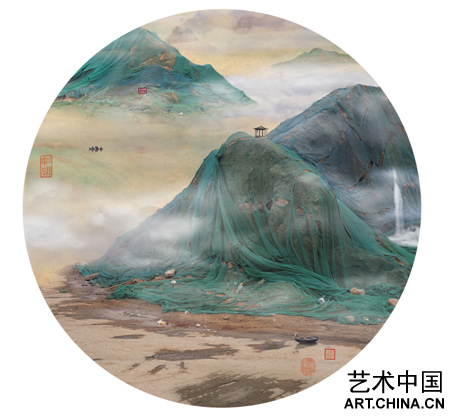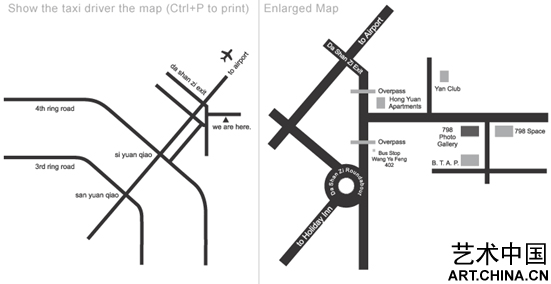|

百年印象摄影画廊
798 PHOTO GALLERY
姚璐作品展 The Photography of Yao Lu
遮蔽与重构——新山水Concealment and Restructuring—New Mountains and Waters
遮掩就是现实的本质——姚璐的《中国景观》
顾铮
当代中国的翻天覆地的变化,给予中国艺术家以新的刺激,激发他们的艺术感性。中国本身的丰富变化也给了艺术家以新的素材。姚璐的摄影巧妙地找到了一个属于他自己的素材,并从此着手,展开他的当代中国风景的重建。
姚璐的《中国景观》系列,运用高超的数码技术,以今天的北京到处可见的一堆一堆由绿色(偶尔黑色)防尘布所遮掩的建筑材料(或垃圾)为素材,往上添加少许亭台楼阁与小舟,拼凑成一个个看似精心构思的青绿山水画面。但细看之下,却会发现还有头戴安全帽的当代民工行走于青山绿水间,骤然显出某种时空上的不和谐。本来,按照想象与文化惯例,游走于青山绿水间的当然是士大夫与渔人樵夫,但哪里想到画面中是头戴安全帽的工人大步踏入风景,惊破梦幻与想象。原来,这充满诗情画意的画面,来自于大兴土木的当下现实,也在影射处处都在大兴土木的现实。姚璐敏锐地捕捉到了当代中国的新符号:防尘布。经过他的机智运用,我们终于不得不接受这样一个事实,那就是那些建筑工地上用来遮掩丑陋、防止扬灰、防止偷盗的绿色防尘布以及由它所披挂而成的座座土堆,已经成为了当代中国的新符号。
在这个目前开发仍然是主要着力点的国家里,绿色防尘布俨然是一种开发中的标志。一个城市,如果没有了这一堆一堆的由防尘布遮掩起来的绿色山包与土堆,也许反而会让人觉得不熟悉、不自然,不自信、不安全。因为这可能就说明,这个城市没有活力,没有受到资本的青睐,权力也没有到位。总之,城市因为没有开发而没有进入现代化的进程,也就是说,这个城市没有前途。而安全也是与开发联系在一起,没有开发,就意味着被遗弃,意味着落后。在这里,由绿色防尘布构成的景观,喻示着一个城市的命运,成为了城市的新象征符号。而且这一景观,始终处于一种动态的过程中,绿色的山包不断出现,不断消失。或者如垃圾那样,不断地出现,不断地被移走。或者如建筑材料,不断地被运走,又不断地被运来。
不过,在姚璐的画面里,一切并不像上面所说的那么直接显然。画面中所显示的是,绿色所遮掩的,以及它所无法掩蔽的,这两者所形成的一种紧张关系。这是一种掩盖与暴露相持不下的张力状态,而这种状态,似乎正好是中国目前的现实。画面中的山冈由绿色这层表皮所塑造,但又处处绷裂露馅,寓言了现实的不可揭发性。如果揭开那层绿色,就等于揭发了现实的底细。这样的画面让人不得不产生这样的联想,在世界美丽的表皮之下,现实或者现实的素材竟然就如此的不堪入目。而现实与想象之间的共谋关系的解体,就在揭开、揭发的一瞬间。也许,从这里我们获得的启发是,遮掩就是现实的本质。现实如果没有遮掩,现实本身就没有魅力可言,而生活本身也将失去想象。这层道理,是以姚璐所呈现的破绽百出的美来提示的。画面中的山山水水,不断有意外的事物来戳穿这个美的虚伪与虚假,绿,显得勉为其难,总是有那底下的泥土要来挣脱这绿色的专制,要来撕毁、破坏这个绿色的表面的和谐。整个画面远看和谐,近看却处处显示出一种左支右绌,处处透露内里的贫乏与贫困与本质上需要的遮掩。也是在这里,人们发现,遮掩也成为了一种对于现实来说是必不可少的手段,不,遮掩本身就是我们的现实了。难道这不正好影射了我们当今面临的真实处境吗?
不过,姚璐的这种看法,却是以一种审美的方式表现出来。他的作品是以丑陋来营造一种美的错觉。在转换丑陋为审美对象时,丑陋本身在成为了一种新的审美对象的同时,也提供对于美本身的潜在的批判与反思的火药。他从丑陋本身当中寻找审美的新世界。
稍微熟悉中国艺术史的人可能都会马上发现,姚璐的作品挪用了宋代绘画的风格。在今天的中国当代艺术里,挪用已经是一种司空见惯的手法。的确,美丽的宋画,至今仍然给予艺术家以灵感,诱人与之对话。而挪用,则是与之展开对话的形式之一种。不过,他的挪用,并不是生硬的、形式的、因而也是机械的外观的套用,而是一种机智的发挥。他与传统对话,醉翁之意却是在当下现在。他希望能够让我们通过他的作品,看到他对于现实的一种看法。
他的挪用,贯穿了一种超现实主义的立场,变现实中的物品为审美对象,从现成品中发现审美的可能性。同时,这又是后现代意义上的挪用,也就是说,传统经过挪用得以激活,但又在赋予传统以新的敞开的可能性的同时,也呈现了对于当下现实的一种个人评价。所有这些企图,被姚璐集纳于一个完美的古典形式中,在把现实经过PHOTOSHOP的重新合成之后,形成一个新的景观。如果只是单单形式上的挪用,并不会对于古典与当代实践产生新的能量置入与激励。
姚璐的挪用当然激活了传统,但更重要的是激活了现实,激活了对于现实的认识与想象。他与传统对话并不仅仅停留于用自己的实践对传统做出一种评价,而是通过与传统的对话发现与建立跟当下现实的新关系。他的意义在于,发现与现实重新建立联系的可能性,居然在于传统之中。当代艺术为了什么目的而挪用?把玩甚至玩弄传统当然都是可以的,但如何通过传统与现实发生并建立起一种联系,这是姚璐的实践给我们的新启示。姚璐的实践也表明,挪用不是一种停留于表象与表面的影像游戏,而是一种寻找更深地介入现实、深入到表象背后、争取自我表达的更大自由度的新利器的过程。
Concealment Is the Essence of Reality----Yao Lu’s “Chinese Landscapes”
By Gu Zheng
The great changes that happened to contemporary China has endowed Chinese artists with new excitements that spur their artistic sense. The Changes themselves have also brought them with new materials. Yao Lu’s photography ingeniously found a material that belongs only to himself from which he began with his reconstruction of contemporary China’s landscape.
With the superb digital technique, Yao Lu’s series of “Chinese Landscapes” takes as material piles of green (occasionally black) dustproof cloth-covered construction materials (or garbage) that can be seen everywhere in today’s Beijing on which he adds pavilions and towers, making landscape paintings that seem to be carefully worked out. But with careful observation, you will find modern peasant workers with safety halmets walking between the mountains and waters, protruding a sudden disharmony of time and space. According to common imagination and culture, those who walk between the mountains and waters should be scholar officials, fishermen, and woodcutters, but in the picture, it is the workers wearing safety halmets who step into the landscape, breaking dreams and imagination. So this poetic picture comes from modern consutruction, and indicates the reality full of construction. Yao Lu keenly caught the symbol of contemporary China: dustproof cloth. Through his clever application, we finally have to accept such a truth: the green dustproof cloth for covering ugliness and preventing dust and theft and the mounds they form have become a new symbol of contemporary China.
In this country where development is still its major focus, green dustproof cloth is a sign of “under construction”. If a city does not have such green hills and piles covered by dustproof cloth, it may look unfamiliar, unnatural, inconfident, and unsafe, as it may indicate that the city lacks vigor, and is not favored by capital and power. In short, the undeveloped city has not entered modernization process, or in other words, it has no future. Safety is also linked with development. No development means being deserted and lagged behind. Therefore, the landscape formed by green dustproof cloth implies a city’s fate, and becomes the city’s new symbol.
Moreover, the landscape is always in a dynamic process in which green stacks keep appearing and disappearing; or, like garbage, keep coming and being carried away; or, like construction materials, keep being moved away and in.
However, in Yao Lu’s pictures, nothing is so direct and obvious as described above. The pictures show the concealed and the unconcealable by greenness, and the tension formed by them. This tension between concealment and exposure seems to be exactly China’s present reality. The hills in the pictures are covered by this greenness while gaps appear everywhere, implying the unrevealability of reality. Uncovering the greenness means uncovering reality. The pictures unavoidably lead us to ponder that under the world’s pretty surface, reality, or materials of reality, should be so ugly. The alliance between imagination and reality resolves right at the moment of exposure. We probably will gain the revelation that concealment is the essence of reality. Reality itself will have no charm without concealment, and life will also lose imagination. This inspiration is indicated by Yao Lu’s beauty full of breaks. The greenness looks so grudging with unexpected items piercing the false and hypocritical beauty of the mountains and waters in the pictures. The earth underneath always tries to break the dictation of the greenness and tear and destroy the green harmony on the surface. The whole picture looks harmonious from far while when observed from near, it presents inadequacy, the needy and poor inside, and the concealment that is an intrinsic necessity. It is also from here that people find that concealment has also become a necessary method. No, concealment itself is already our reality. Doesn’t it allude to the true situation we are now in?
However, Yao Lu’s opinion was expressed in an aesthetic way. His works create an illusion of beauty with ugliness. By transferring ugliness to an aesthetic target, the former provides the gun powder for possible criticism and reflection of beauty itself while becoming a new aesthetic target. He looks for a new aesthetic world from ugliness itself.
Those who know something about Chinese art history may quickly find that Yao Lu’s works draw the style of Song Dynasty’s fine art. Drawing other factors is a common method in contemporary Chinese art. Indeed, the beautiful paintings of the Song Dynasty still bring inspiration to artists today and attract their dialogues. Drawing its style is one type of the dialogues. But Yao’s drawing is not a rigid, formal, therefore machenical application; instead, it is a clever performance. He talks with tradition, but aims at the present. He expects us to see his opinion about reality through his works.
Taking an extrarealistic position, his drawing transfers real items to aesthetic targets and finds aesthetic possibilities from them. At the same time, it is a postmodern drawing, which means that it activates tradition, attaches tradition with new possible opening, and presents a personal evaluation of the present. All these purposes are collected by Yao Lu in a perfect classical form, photoshoping reality and creating a new landscape. If it were simply a formal drawing, it would not have encouraged and inserted energy into the classical and modern practice.
Of course, Yao Lu’s drawing activates tradition, but more importantly, it activates reality and the knowledge and imagination of reality. His talks with tradition do not stop at evaluating it with his own practice, but establish a new relationship with reality by the dialogues. Its meaning lies in finding that the possibility of reconnecting with reality lies in tradition. For what modern art draws other factors ? It is fine to play or even juggle with tradition, but how to bring about and set a link with reality through tradition? That is what Yao Lu’s practice inspires us to think about. His practice also shows that drawing is not a photographical game that lingers on the surface; instead, it is a process through which people search for a sharper weapon to dig into reality and the back of surface, and reach for a wider freedom of self-expression.
开幕时间:2008年6月28日15:00
展期:2008年6月28日至2008年7月
电话:010-64381784/64375284
电邮: 798@798photogallery.cn
网址:www.798photogallery.cn
地址:北京朝阳区酒仙桥路4号798工厂内大山子艺术区百年印象摄影画廊
Opening time: June.28 3:00pm ,2008
Exhibition time:June.28,2008 –July. 2008
Tel:8610-64381784/64375284
E-mail:798@798photogallery.cn
Web:www.798photogallery.cn
Add:No4,Jiu xianqiao road,Chao Yang district, BeiJing.
DIRECTION: 798 PHOTO GALLERY

|

